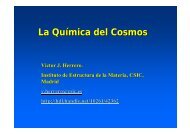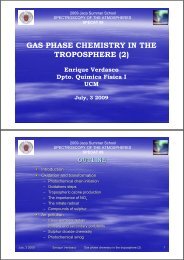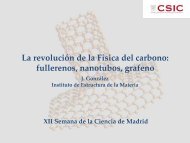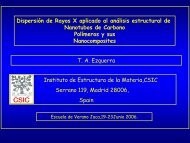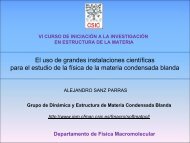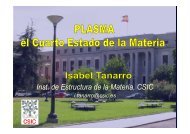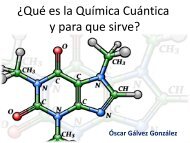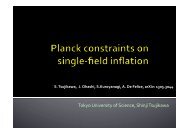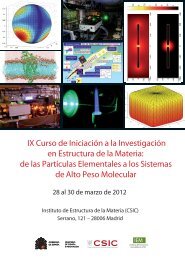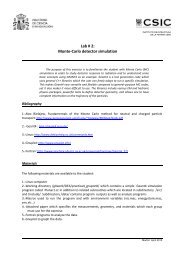ANNUAL REPORT 2011 - Instituto de Estructura de la Materia
ANNUAL REPORT 2011 - Instituto de Estructura de la Materia
ANNUAL REPORT 2011 - Instituto de Estructura de la Materia
Create successful ePaper yourself
Turn your PDF publications into a flip-book with our unique Google optimized e-Paper software.
towards potential optical metamaterials <strong>de</strong>signed on the basis of the physics un<strong>de</strong>rlying our doubly-resonant metalodielectricconfiguration. These physical principles can of course be exploited at lower (far-IR and terahertz)frequencies, at which some dielectric materials exhibit very <strong>la</strong>rge refractive indices and certain materials (e.g. po<strong>la</strong>rcrystals, doped semiconductors) behave as p<strong>la</strong>smonic metals. Finally, it should be emphasized that the requiredfabrication means will open a novel route towards the nanosynthesis of NIM.Schematic representation of the physics behind the core-shell configuration. The strong diamagnetic response is dueto the lowest, dipo<strong>la</strong>r magnetic resonance in the shell, where the electric field is forced to rotate as a consequence ofthe abrupt continuity conditions for the normal component between the shell and the surrounding medium. Theelectric resonance is a LSPR in the metal core.LASER INDUCED BREAKDOWN SPECTROSCOPY (LIBS)We have studied the Laser Induced Breakdown Spectroscopy of CO 2 at different pressures by using high resolutionOptical Emission Spectroscopy. The strong emission of the CO 2 p<strong>la</strong>sma shows excited neutral O and C atoms andionized O + and C + species. The medium-weak emission is due to electronic re<strong>la</strong>xation of excited species C 2+ , O 2+ ,N + , N, H and molecu<strong>la</strong>r band systems of C 2 , CN, O 2 , O + 2 , N 2 and N 2+ . Threshold intensities, p<strong>la</strong>sma temperature andvelocity distributions for different species were obtained. Electron <strong>de</strong>nsity in the <strong>la</strong>ser-induced p<strong>la</strong>sma was estimatedand from the TOF profiles for distinct species the corresponding three-body electron–ion recombination rateconstants were obtained. The <strong>la</strong>ser-induced breakdown spectroscopy of He at several pressures has been studied.The helium breakdown spectrum is mainly due to electronic re<strong>la</strong>xation of excited He, He + and H. P<strong>la</strong>smacharacteristics were examined by the time-integrated and time resolved optical emission spectroscopy. Opticalbreakdown threshold intensities, ionization <strong>de</strong>gree and p<strong>la</strong>sma temperatures were obtained. The velocity and kineticenergy distributions for He and He + species were obtained from time-of-flight measurements. Electron <strong>de</strong>nsity andits temporal evolution have been used for the estimation of the three-body electron–ion recombination rate constant.A review of some fundamentals of LIBS and some experimental studies <strong>de</strong>veloped in our <strong>la</strong>boratory on gases suchas nitrogen, oxygen and air has been done as a book chapter. The physical processes leading to <strong>la</strong>ser-inducedbreakdown of gases have been analyzed. Optical breakdown threshold intensities in different gases have beenexperimentally measured. Excitation temperatures and electron number <strong>de</strong>nsities are estimated from the intensitiesand the Stark broa<strong>de</strong>ning of several ionic lines. The velocity and kinetic energy distributions for the different specieswere obtained from time-of-flight (TOF) OES measurements. Temporal evolution of electron <strong>de</strong>nsity has been usedfor the estimation of the three-body recombination rate constant. The previous results of LIBS in different samples(He, Ge, GeH 4 and CO 2 ) have been reviewed for the publication of a book chapter. These works have been done incol<strong>la</strong>boration with Profs. J.J. Camacho and J.M. Poyato (Phisical-Chemistry Department of UAM).INFRARED LASER INDUCED ABLATION PLASMASIR CO2 Laser Induced Ab<strong>la</strong>tion of graphite target has been studied. Analyzes with spatial and temporal resolutionfor the p<strong>la</strong>sma plume were done. Wavelength-dispersed spectra of the plume reveal the emission of C, C + , C 2+ , C 3+ ,C 4+ , N, H, O, N + , O+ and molecu<strong>la</strong>r features of C 2 , CN, OH, CH, N 2 and NH. Excitation, vibrational and rotationaltemperatures, ionization <strong>de</strong>gree and electron number <strong>de</strong>nsity for some species were estimated. This work has beenpublished as a book. Time-resolved optical emission spectroscopy has been applied in the <strong>la</strong>ser-induced ab<strong>la</strong>tionplumes of germanium targets. The temporal behavior of Ge atoms and ionized excited species Ge3+, Ge2+, and Ge+have been studied. The velocity distributions and the three-body electron-ion recombination rate constants for these65




